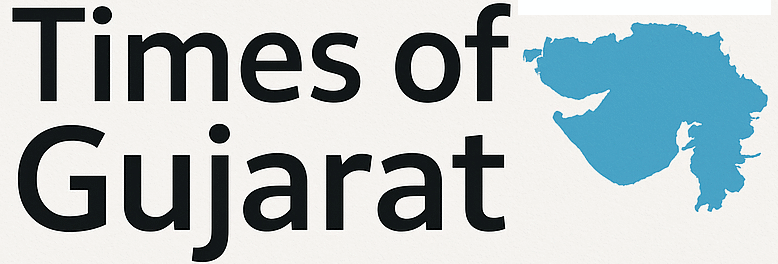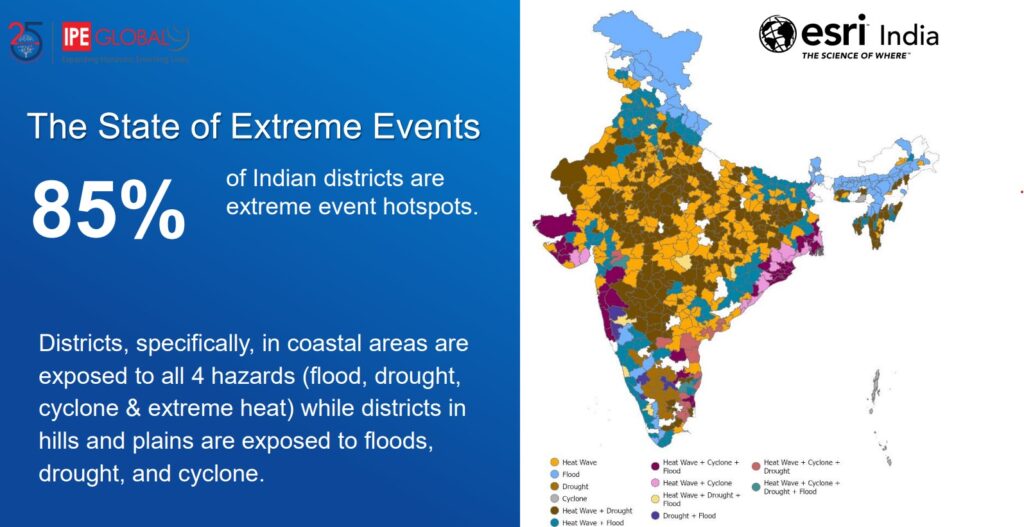The study also found that 45 per cent of Indian districts are witnessing a swapping trend i.e. traditional flood prone areas are becoming drought prone or vice-versa
September 2024: Over 85 per cent of Indian districts are prone to flood, drought, cyclone and heat waves, of which 45 per cent of them are witnessing a swapping trend, according to a independent study released today by the IPE-Global and Esri-India. The frequency, intensity, and unpredictability of these climate extremes have also risen in recent decades by four-fold. Using a pentad-decadal analysis, the study compiles a catalogue of extreme climate events over a 50-year historical period from 1973 to 2023 by employing spatial and temporal modelling, the research provides a detailed district-level assessment, exploring the complexities and non-linear trends and patterns of these events. Last decade alone has witnessed a five-fold increase in these climate extremes. The study also found that over all climate risk landscape of the Indian districts is fast changing. The study was launched at Climate Technology Summit’s plenary session titled “Leveraging GIS Technology to Mitigate Climate Risks” organised by Esri-India and its partner IPE Global – as the world is gearing up for the Climate Week NYC, USA where business leaders, political change makers are expected to deliberate the on-climate action commitments.
Abinash Mohanty, Head- Climate Change and Sustainability Practice at IPE Global and the author of the study, said, “The current trend of catastrophic climate extremes that makes 9 out 10 Indians exposed to extreme climate events are a resultant of 0.6 °C temperature rise in the last century. El Nino is gaining momentum and making its early presence felt across the globe with India facing the extreme events turbulence more in patterns than waves. Recent Kerala landslides triggered by incessant and erratic rainfall episodes, floods in Gujarat, disappearance of Om Parvat’s snow cover and the cities getting paralysed with sudden and abrupt downpour is a testament that climate is changed. Our analysis suggests that more than 1.47 billion Indians will be highly exposed to climate extremes by 2036 and these numbers peak of volumes. Embracing hyper-granular risk assessments and establish climate-risk observatories and infrastructure climate fund should become a national imperative to safeguard Indian economy especially for sensitive sectors like agriculture, industry, and large-scale infrastructural projects from the vagaries of climate change.”
More than 60 percent of districts in Bihar, Andhra Pradesh, Odisha Gujarat, Rajasthan, Uttarakhand, Himachal Pradesh, Maharashtra, Uttar Pradesh, and Assam are witnessing more than one extreme climate events.
The IPE Global study found that, Eastern zone districts are more prone to extreme flood events, closely followed by the north-eastern and southern zones of India. There has been a 4-fold increase in extreme flood events across Indian districts. The increase in greenhouse gases emissions, unplanned landscape planning and unsustainable anthropocentric activities are triggering these climate extremes and its likelihoods. The study finds region specific district.
Findings from the study suggest, there has been a 2-fold increase in drought events especially agricultural and metrological droughts and four-fold increase in cyclone events.
Ashwajit Singh, Founder and Managing Director- IPE Global, said, “ While India’s per capita CO2 emission is 1/3rd that of global average and a fraction of the developed nations like USA and China but it faces burnt of climate change the most. Climate is ‘Code Red’ and a risk multiplier that makes worse already existing challenges. With the world progress alarmingly insufficient on UN SDG index, climate change is a global emergency inextricably linked with sustainable development. India fairs very well when it comes to its compliance with SDG targets for climate change. To meet climate goals, India must shift its budget focus from mitigation to adaptation. Current practices underfund climate resilience, risking long-term sustainability. India, in particular, experienced an 8 per cent GDP loss in 2022 and a cumulative capital wealth decrease of 7.5 percent due to climate impacts. We at IPE Global realise that tackling the climate crisis requires movement-building and on-the-ground action. We are continuously striving to develop and implement strategies that convert environment risks into competitive advantage- and this study is a testament to how we can bring innovations from margins to mainstream that make India and Global South climate ready. By fostering partnerships across sectors, investing in innovation, and empowering communities, we believe that India can pave the way to become the climate solutions capital to the world” to build a sustainable future which creates harmony between people and planet.”
Agendra Kumar, Managing Director, Esri India, said, “Building climate resilience requires maintaining a delicate balance of both climate adaptation and mitigation approaches. Geography is key, be it for understanding future climate projections for policy interventions or efficiently planning intervention approaches such as nature-based solutions, technological solutions, or social solutions. GIS technology, with advanced spatial analysis tools and the ability to integrate a variety of data, enables this geographic science approach. GIS technology is already the core foundation of various environmental initiatives, disaster resilience programs, infrastructure, utilities, natural resources management, and missions like smart cities, AMRUT, National Water Mission, and Clean Ganga among others. GIS-driven solutions like Climate Risk Observatory with vulnerability maps, apps, and data have the potential to help stakeholders better understand the sectoral impacts of climate change and build a more resilient future.”
Mapping the swapping trends
The study found a trend that more than 45 per cent of Indian districts are witnessing a swapping trend i.e., with some flood-prone areas now becoming more susceptible to droughts, and vice versa and combination of both the hazards. The number of districts that have transitioned from experiencing floods to facing droughts surpasses those that have shifted from droughts to floods. Several districts, including Srikakulum, Cuttack, Guntur, Kurnool, Mahbubnagar, Nalgonda, and Paschim Champaran, among others, have seen this reversal from floods to droughts. Southern India, particularly states like Andhra Pradesh, Tamil Nadu, and Karnataka, are witnessing a notable increase in drought conditions. Bengaluru Urban, Pune, Ahmedabad, Patna, Prayagraj districts are witnessing the maximum swapping trends. Districts such as Rajkot, Surendranagar, Ajmer, Jodhpur, and Aurangabad have also exhibited both flood and drought. Districts in the states of Tripura, Kerala, Bihar, Punjab, Jharkhand are observed with maximum swapping trends.
The study also found that districts that identified district hotspots have undergone a 65 per cent change in land-use-land-cover. These changing patterns are due to microclimatic changes across the Indian subcontinent that are triggered by local climate change drivers such as land-use-surface change, deforestation, encroachments upon mangroves, and wetlands.
The study recommends that establishment of a Climate Risk Observatory (CRO), a risk-informed decision-making toolkit for decision-makers at the national, state, district, and city levels under its National Resilience Programme and establishment of an Infrastructure Climate Fund (ICF) to support sustained investment into climate-resilient critical infrastructure and foster locally led climate actions. ICF can be geared towards enhancing the markets’ capacity to absorb increased risk at optimal return periods, fortifying their ability to navigate the ever-evolving landscape of risks adeptly.
The IPE Global and Esri study holds significance as it provides a micro-level hazard assessment of climate extremes across Indian districts. It argues that comprehensive risk assessments at the hyper-local level are the need of the hour and relying just on global models will not be effective. Moreover, identifying and estimating climatic risks is one of the global call-to-action to climate-proof lives, livelihoods, infrastructure and economies at the India pitch to United National Framework on Climate Change’s reporting.
Methodology
This study represents a pioneering effort in profiling extreme climate events—such as heatwaves, cyclones, floods, and droughts—at the district level across India. By employing spatial and temporal modelling, the research provides a detailed district-level assessment, exploring the complexities and non-linear trends and patterns of these events. In addition to evaluating the frequency of climate disasters, the study investigates the patterns of related events and how their impacts have intensified over time. The study also examines shifts in climate event trends across various sub-regions of the country. Using a pentad-decadal analysis, the study compiles a catalogue of extreme climate events over a 50-year historical period from 1973 to 2023.
About IPE Global
IPE Global Limited is an international development organisation and, providing innovative solutions for anchoring development agenda to create a better world for all. Headquartered in India with five international offices in Bangladesh, Ethiopia, Kenya, Philippines and United Kingdom, the Group offers a range of integrated, innovative, and high-quality consulting services across various sectors. A trusted partner to its clients, IPE Global draws together a team of economists, chartered accountants, sociologists, public sector experts, educationists, urban planners, architects, environmentalists, scientists, climatologist and meteorologists and project and programme managers — all dedicated to finding clear solutions to complex world problems. Over the last 25 years, IPE Global has successfully implemented more than 1,200 projects in over 100 countries across five continents. The Group partners with multilateral and bilateral agencies, governments, corporates and not-for-profit entities in anchoring development agenda for sustained and equitable growth.
About Esri India
Established in 1996, Esri India Technologies Pvt. Ltd. (Esri India), the market leader in geographic information system (GIS) software, location intelligence, and mapping solutions in India, helps customers unlock the maximum potential of their data to improve operational and business decisions. It has delivered pioneering enterprise GIS technology, powered by ArcGIS, to more than 6,500 organizations in government, private sector, academia, and non-profit sectors. The company has also introduced ‘Indo ArcGIS’, a unique GIS solution & data offering suited for government organizations. Esri India collaborates with a rich ecosystem of partner organizations to deliver GIS and location intelligence-based solutions. Headquartered in Noida (Delhi NCR), the company has about 1 million users in the country. It got Great Place to Work Certified® in 2021, 2022, and 2023. For more information visit www.esri.in.
The study, “State of Extreme Events,” can be accessed here and the detailed analysis and outputs can be accessed from the IPE Global and Esri India’s Climate Risk Observatory Tool.






More Stories
Bishop Games 6.0 Flags Off with a Grand Bike Rally, Uniting 600+ BNI Entrepreneurs Across Five Cities
Mafatlal Industries strengthens its sustainability commitment, commissions a 4 MW solar power project at its Nadiad plant
India Watches COP11 Debate on Tobacco Harm Reduction and WHO Policies